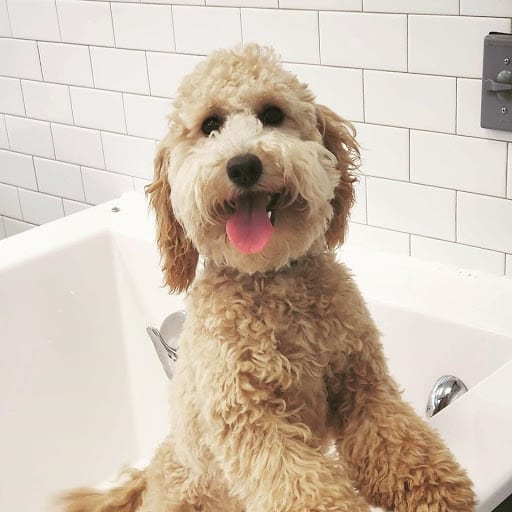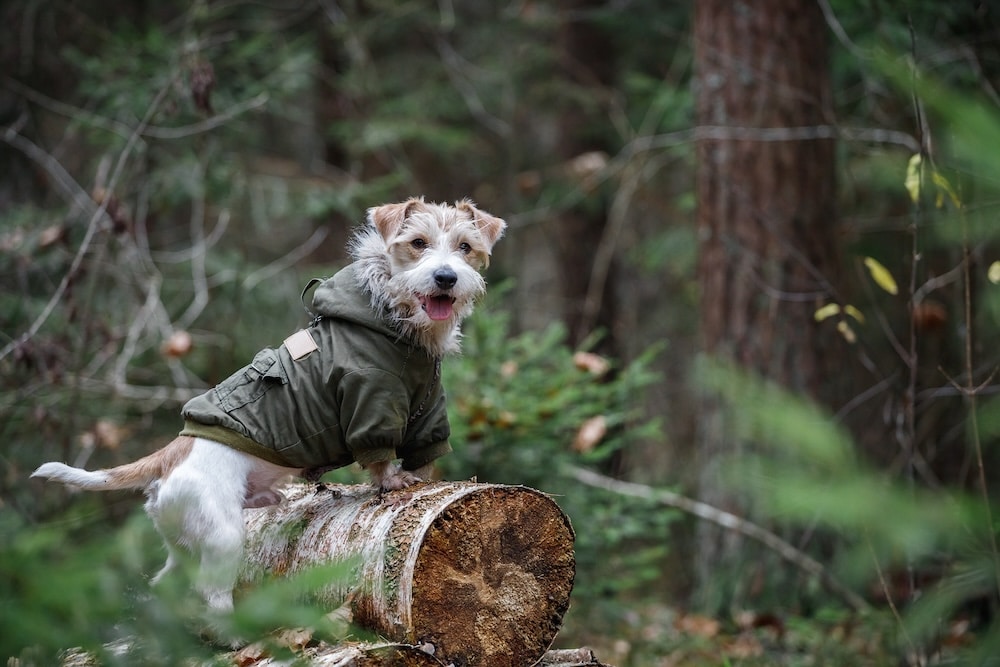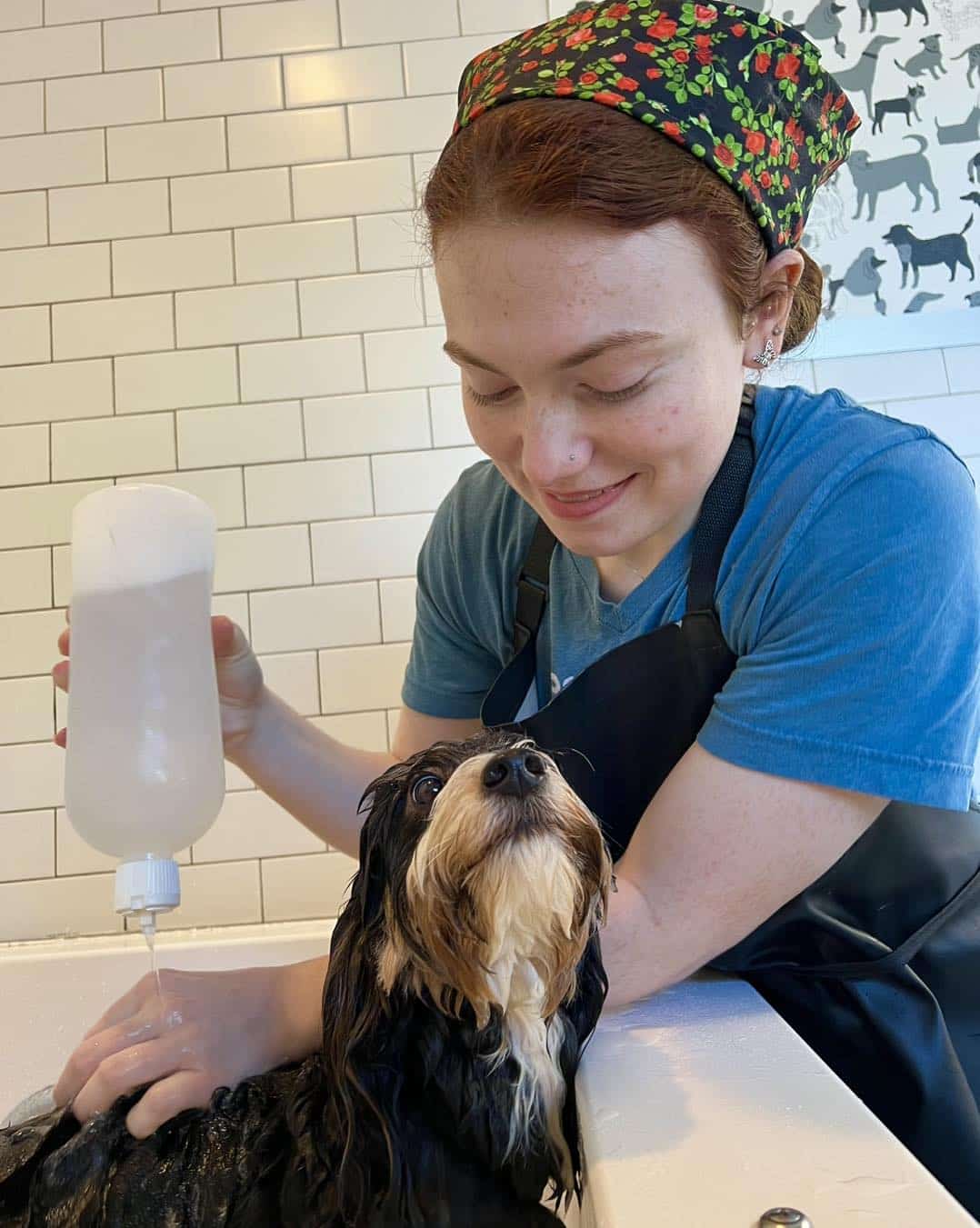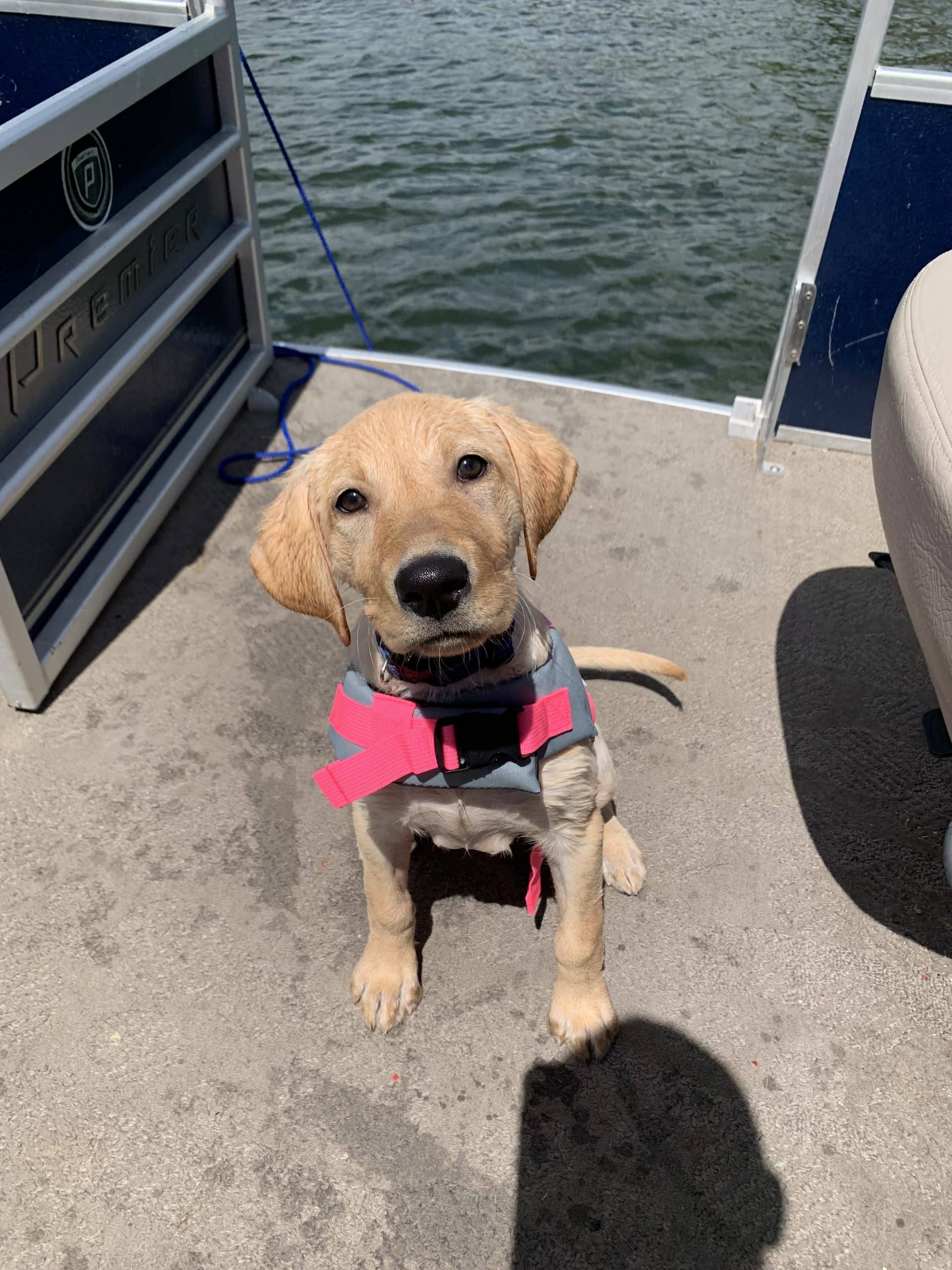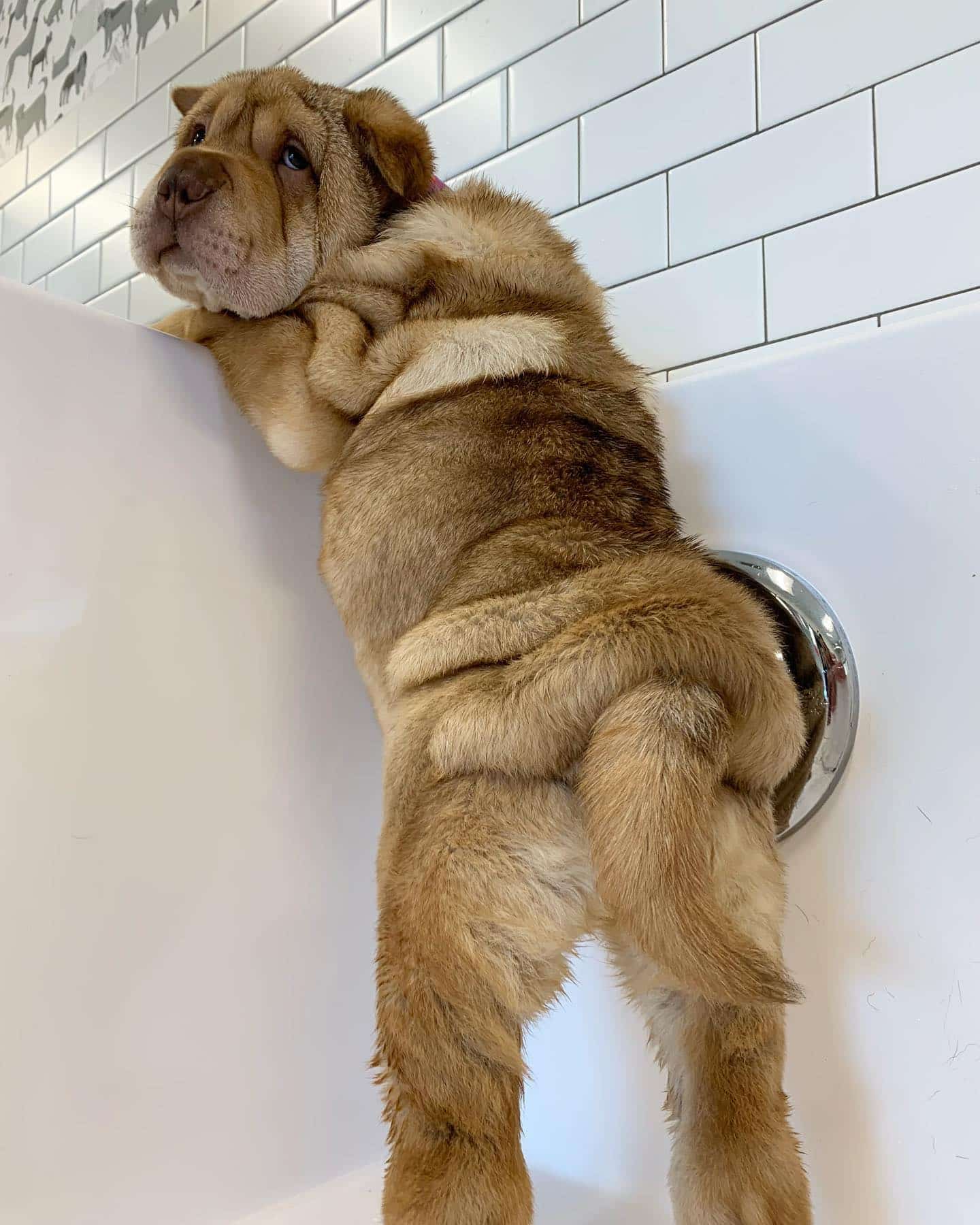A routine grooming and style guide for our most popular breeds seen at Hounds Lounge Pet Resort and Spa.
Keeping up with your fur child’s grooming schedule can seem daunting at times, especially around shedding seasons. Dawg hair is a major issue facing all dog moms and dog dads!
From avoiding mats and tangles to keeping our fur child’s coat looking pawsome, our dog groomers know just how challenging this can be. Because we want to help you help your fur babe be healthy, happy and well-taken care of, we’ve created a dog grooming and styling guide for our most popular breeds at the Lounge, including Golden Retrievers, Goldendoodles, Labradoodles, Huskies, and Dachshunds.
Read on to dig up all your answers about how to groom and maintain your pooch’s healthy coat, nails, and more.
The Bare Bones of Dog Grooming
Regular dog grooming, including brushing and nail trimming, can go a long way in helping your pooch become accustomed to being handled, bathed and trimmed. Some dawgs can develop severe grooming anxiety and must be handled with great care and gentleness. With a routine grooming schedule and plenty of patience, doggos can become more used to being pampered while enjoying the bountiful health benefits.
Regularly brushing your woof’s coat and performing mani-pedis on your pooch will help prevent severe coat matting, reduce shedding, keep his or her nails at a healthy length, and will help prevent skin and ear infections. So get comfy and use this grooming and style guide to help keep your furbabies looking silky-smooth and fabulous.
Feel free to skip to:
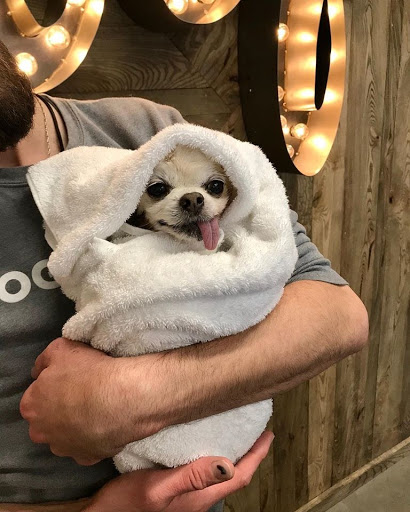
Brush and Comb Types
Different strokes for different doggos, right? When deciding to regularly groom your dog, it’s important to have the right equipment. Trust us, it’ll make your job a lot easier!
There are several different brush types that work well on different breeds.
- Slicker Brushes – These brushes have small, fine wire bristles. These brushes are best used on medium to long-haired dogs with thick coats. The brush works well to reduce the amount of shedding out of the undercoat of dogs such as Golden Retrievers and Labradoodles.
- Rakes – Also known as de-matting combs, these brushes work well in breaking up mats that are close to the skin on dogs with thick fur and undercoats. It’s important to keep matting to a minimum as these hairy knots can be painful to our beloved pooches and can cause discomfort when getting a professional groom.
- Bristle Brushes – These brushes are made up of tightly-packed bristles and work best on short-haired dogs such as Short-Haired Dachshunds and Weimaraners to remove loose hairs and reduce shedding.
- Steel Combs – Steel combs can be used after a slicker brush on medium to long-haired breeds to break up any remaining tangles or mats. These also give your pooch’s coat a nice smooth texture.
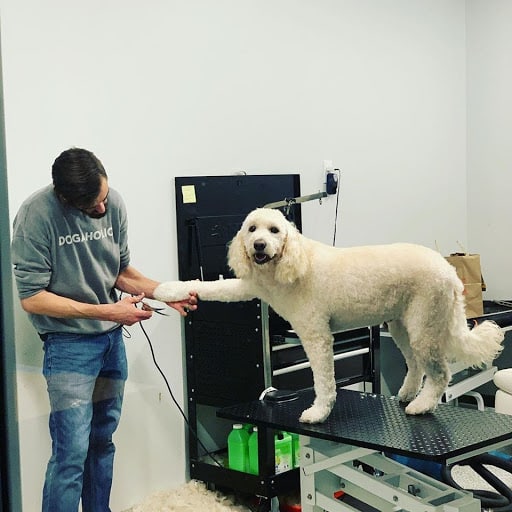
Nail Trimming Tools by Breed Size
Nail trimming can be a grooming task that goes largely ignored until woofs come in for a full spa day and dog grooming at Hounds Lounge. Keeping up with your woof’s nail trim schedule can often prevent painful breaks in the nails and any bleeding that may result. It is best that all doggos receive a nail clipping once a month to prevent any issues or breaks.
Here’s a guide to finding the right nail trimming tools for your woof:
- Scissor Clippers – these clippers often work best on large dogs with thick nails. It’s extremely important to make sure not to clip the quick, or live part of the nail. You should be able to see a small dark center inside the nail when viewing it head-on – this is the quick and the nail should not be cut too close to this point.
- Guillotine Clippers – this type of clipper will work best on small to medium-sized dogs whose nails will be able to fit in the smaller opening. These clippers work by gently cutting off portions of the nail grown out past the quick with a blade plate that slides underneath a circular opening in which the dog’s nail fits into.
- Dremel – This particular type of nail file is electric and uses grinding to reduce the length of your doggo’s nails. This electric file can take some time to get your fur babe used to, so be patient and go slow.
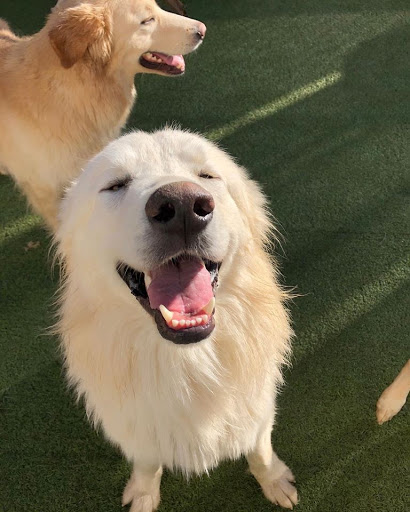
Complete Grooming and Style Guide for Golden Retrievers
Golden Retrievers often need less trimming than breeds such as Poodles or Labradoodles. This is because of a Golden’s medium-length double coat. These coats help our beautiful blonde furbabies regulate their body temperature during the winter and summer months. The overcoat, or longer topcoat, protects your beautiful golden doggo from the sun’s rays in the summer, while the undercoat, a dense layer of shorter hair, sheds in the summer to keep him cooler and grows back before the winter for an extra-warm layer of insulation.
Best Brushes to Use for Golden Retrievers
Our local dog groomers suggest using a slicker brush on Golden Retrievers due to their dense undercoat. This brush will help remove mats and reduce the shedding you’ll experience inside your house. Steel combs can be used on Goldens after a slicker brush for a freshly groomed look. It is recommended to brush your Golden at least once a week to keep shedding to a minimum.
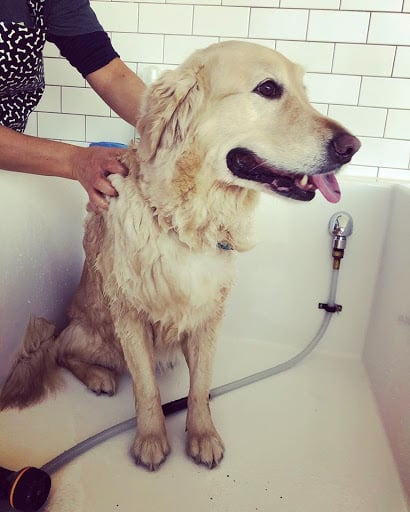
Bathing Your Golden Boy or Gal
A good rule of thumb to follow is to bathe your golden every six weeks or so. This will depend on how dirty your dog enjoys getting and how much time he spends outside. Hounds Lounge recommends a dog-friendly shampoo when washing any precious pooch.
Styling for Your Golden Retriever
Because of Goldens’ double coat, it is best not to shave them during any part of the year. This is because their coat is designed to help them regulate their body temperature. They will be more prone to overheating in the summer if they are shaved than if they are trimmed and well-brushed to reduce matting.
A golden should be trimmed only around their paws, neck, tail, back of the legs and underbody. This is where their longest hair will be found. Professional groomers can also thin a thick undercoat with thinning shears.
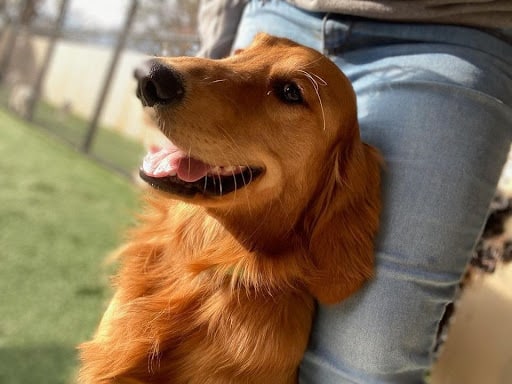
Things to look for in a pawsome golden retriever ‘do include:
- Symmetry and balance in cuts
- An even cut on the bottoms of the feet, flush with paw pads
- A neat and round cut around the feet that falls even with the ground
- The hair on the tail should appear sculpted
- The overcoat is still in-tact
- Long leg, neck and underbody hair should be neatly and evenly trimmed
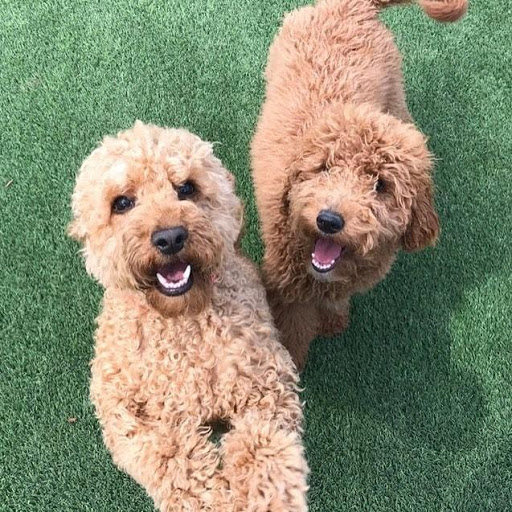
Dog Grooming and Styling for Goldendoodles & Labradoodles
Goldendoodles and Labradoodles are considered designer dogs – also known as crossbreeds. It is important to understand what is required in terms of grooming for your doodle. It can often surprise dawg mommas and dawg dads how much time consistent doodle grooming can take.
Because of the variation in hair types of our cute and cuddly doodles, we recommend bringing in your pup to our groomers for a free grooming consultation, as well as any at-home grooming recommendations you may need to keep your teddy bear’s coat tangle-free…or close!
Best Brushes to Use on Your Goldendoodle or Labradoodle
For coats longer than 1 inch, it is recommended to brush your doodle daily to prevent severe matting of their beautiful coat. Our groomers recommend using a slicker brush to comb out tangles and mats and a steel comb to finish off a well-finished and mat-free look. Brushing a Doodle will take some time – but be patient and hang in there!
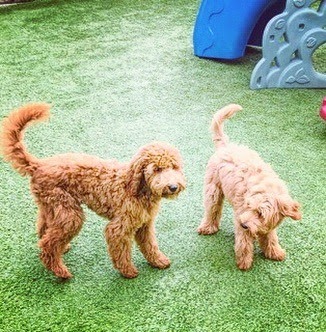
Bathing Your Doodle
The bathing frequency for your doodles also depends on the type of coat they inherit – either closely resembling a poodle or more like a Golden or a Labrador. It is recommended that your pooch is bathed at least once every three months. Depending on your four-legged friend’s coat type, he or she can be bathed as frequently as every other week with a gentle dog shampoo.
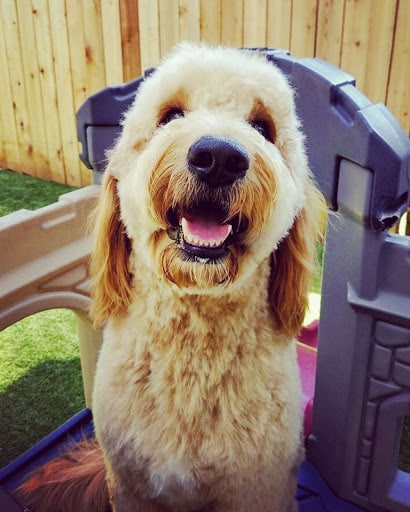
A Grooming and Style Guide for Your Doodles
There are several popular cuts for our beloved doodles including a short clip, a long clip, and a teddy bear cut.
- Short clips leave the fur at about an inch long everywhere on your doodle. A short clipped doodle will need to be brushed several times a week.
- A long clip will require daily brushing and should be 2-4 inches long everywhere on your furriends body.
- Teddy bear cuts will leave the hair at about 2-3 inches long with a rounded shape on your Doodle’s head, giving him a precious, stuffed animal look. D’aww!
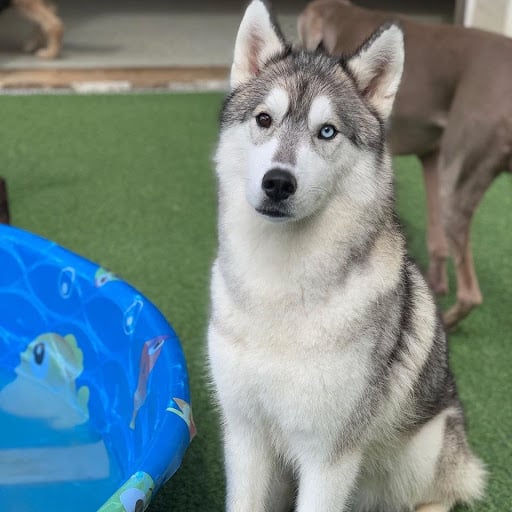
How to Groom Your Husky
Huskies, like Golden Retrievers, have a double coat to help them regulate their body temperature. Unlike Goldens, they do not grow long hair around their neck, back of the legs or underside. The great news: huskies do not need to be trimmed! The okay news: they need to be brushed at least weekly to reduce shedding and help remove the undercoat that thins and sheds heavily twice a year – once during the spring and once during the fall.
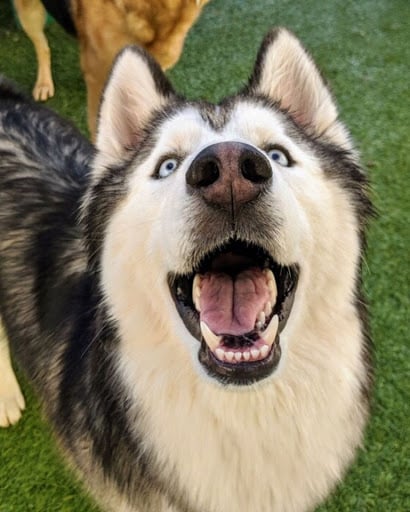
Best Brushes to Use on Your Husky Baby
Huskies are prone to matting in their undercoats which can quickly get out of hand. It’s best to begin brushing at a young age to get your husky pup used to regular grooming. This is also a great time to bond with your beautiful pooch. Our dog groomers recommend using an undercoat rake to remove matted hair as well as a de-shedding comb, such as a Furminator, to remove excess hair that would otherwise end up all over your furniture or clothes. Ru-roh!
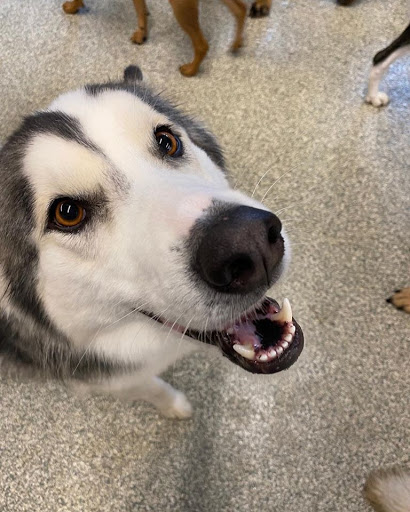
Bathing Your Husky
Huskies have less naturally-occurring oil on their coats than other breeds. Because of this, your husky will not smell and will consequently need fewer baths than other doggos. It is recommended to give them only a few baths per year unless they find their way into something particularly dirty or smelly. Dogs will be dogs! If you happen to have a muddy Husky at any point, bring them into the Lounge for a quick DIY dog wash and dry.
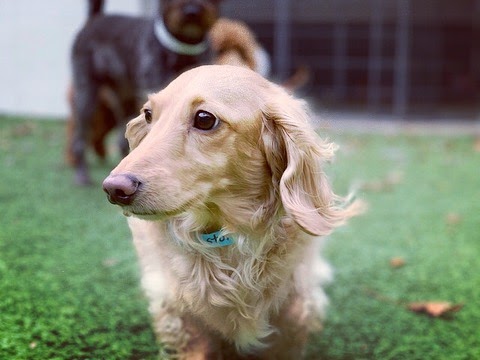
Everything to Know About Grooming Your Dachshunds
Dachshunds can have one of several different types of coats. These include long-haired, wire-haired and short-haired. Your Dauchy’s grooming needs will be specific to his or her coat type, all of which will be covered in this doggone good grooming and style guide.
Bathing Your Dachshund (All Hair Types)
Dachshunds tend to be a very clean breed with minimal dog-smelliness. They do not produce a lot of oil on their coats and often have sensitive skin. Because of this, these little fellas only need a bath once every three months or so – unless they get into something icky.
Our professional Hounds Lounge dog groomers recommend using a fragrance-free doggy shampoo for those with sensitive skin. Oatmeal and aloe shampoos work well to keep their skin in good condition. You can help reduce mats and tangles in your long-haired and wire-haired variety by brushing your pooch before his bath and using an equally sensitive doggy conditioner and rinsing your fur baby well.
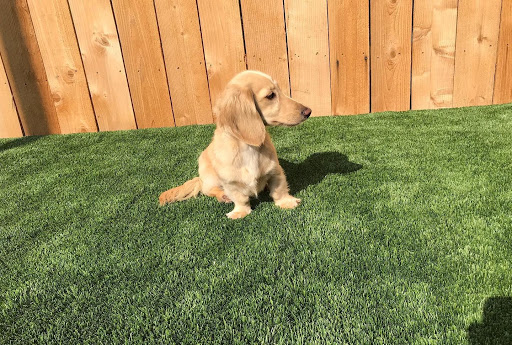
Best Brushes for Long-Haired Dachshunds
Long-Haired Dachshunds require a little more effort than their short-haired counterparts due to their lusciously flowy coats. Our long-haired cuties are prone to developing bad matting, particularly behind their ears and in their tails.
To prevent these from occurring and to reduce the severity of mats, begin your daily brushing with a bristle brush to remove any debris from the topcoat. Next, take a slicker brush all over your precious pooch to remove and loosen any tangles that might be building up. Finally, you can take a steel comb through their long hair to remove any remaining tangles to give them a nice finished look.
Be sure to be careful when brushing your long-hair’s ears and tail as these hairs are very fine and can be sensitive to your pooch.
Au-Natural Styling for your Long-Haired Dachshund
This style for your Long-Haired Dachshund compliments their flowy locks as the hair is kept at a natural length but trimmed up around the ears and underside of your beautiful doggo. Hair will be kept long but tidied up for a sleek, natural look.
Long-Haired Dachshunds only need to be trimmed a few times a year. Since this breed has a double coat, it is important not to shave your dog in the summer months as his coat naturally helps him regulate his body temperature. Instead, opt for a short clipping during the summer months to lighten up your pooch.
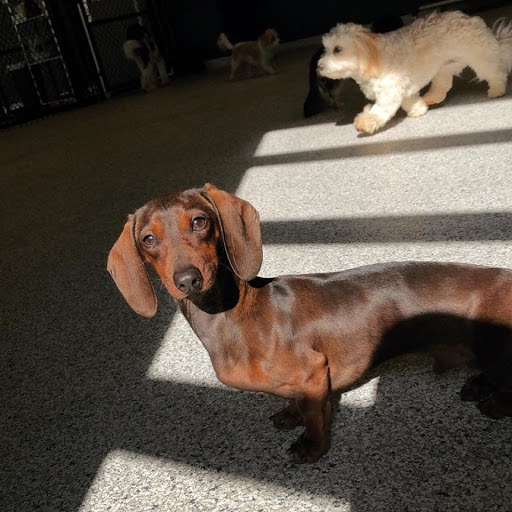
Brushing Tips for Wire-Haired Dachshunds
Brushing your wire-haired dachshund is best done every other day to prevent tangles in his or her coat. A bristle brush will work best on your four-legged companion to help reduce shedding, remove debris from the coat, and detangle mats.
A Wire-Haired Dachshund may require something called stripping twice a year depending on his fur coarseness. Stripping is a process of removing the undercoat of your Dachshund using a slicker brush. This may need to be performed twice a year, once in the spring and once in the fall when you notice your wirehair’s coat is not as vibrant as usual.
Clipping for Your Wire-Haired Doggo
Wirehair varieties will need minimal clipping by a professional dog groomer each year, maybe 1-2 times if they are regularly stripped. If not, then they will require additional clipping. Their styling will look even across the body while the eyebrows and beard are left long but well-shaped and blended into that precious face.
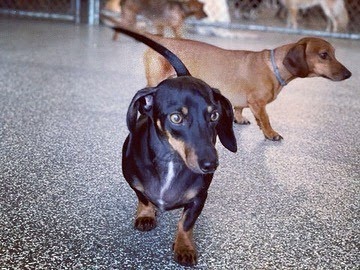
Brushing Tips for Short-Haired Dachshunds
A stiff bristle brush will work best on your short-haired fur babe. This type of brush will help remove any dead hairs and will help reduce shedding if groomed regularly, 1-2 times a week. Your short-haired dawg should not need to be trimmed as his or her coat is naturally short and does not grow out.
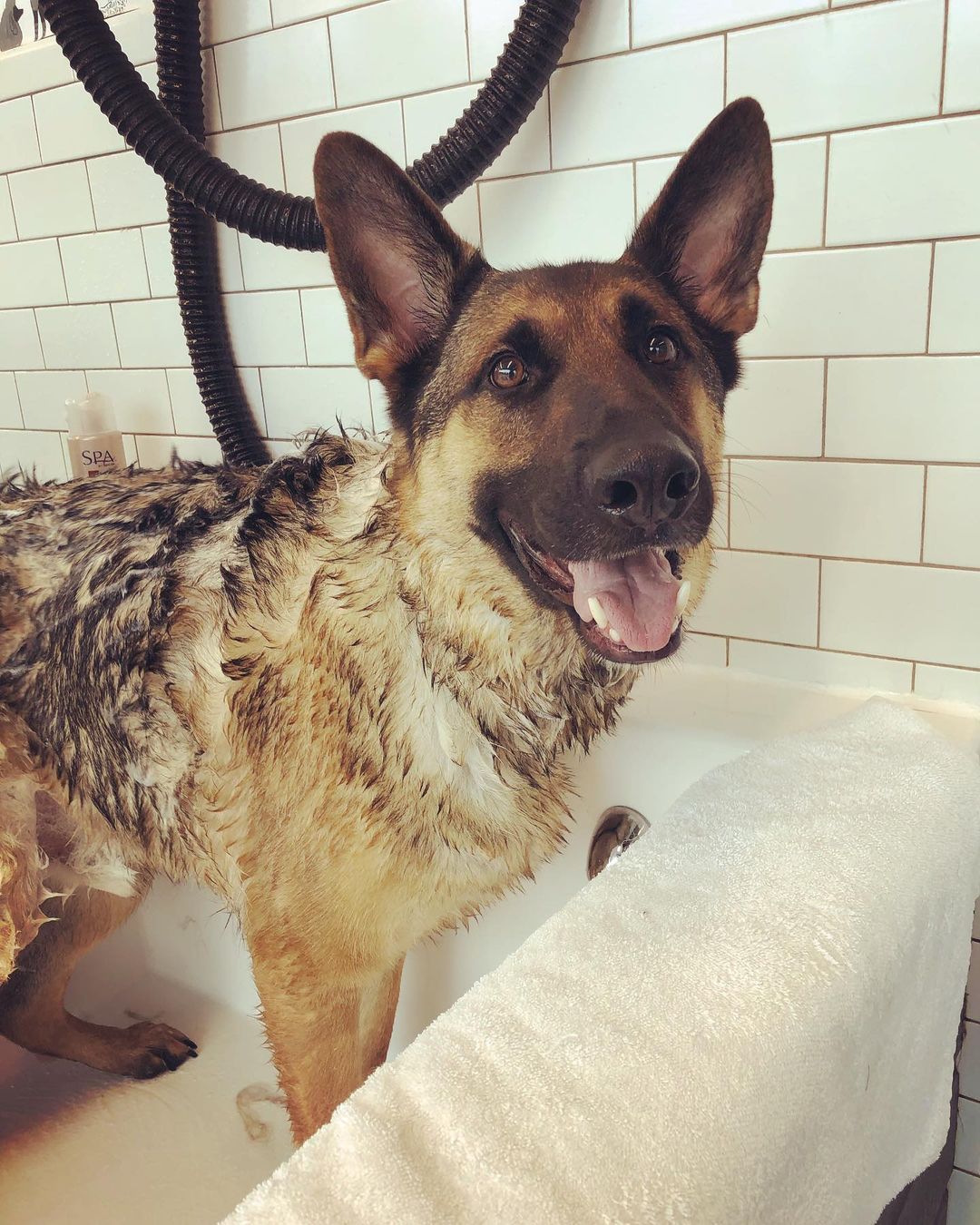
Complete Grooming and Style Guide for German Shepherds
German Shepherds are super furry and great for snuggling, but their medium-length double coats can be somewhat intimidating. While German Shepherds do not need to be groomed nearly as often as their doodle friends, they do require upkeep to tone down their shedding and keep them looking tidy.
German Shepherds have dense outer coats and soft undercoats, because of this it’s important to brush your furry friend frequently to combat shedding. Every couple of days should generally do the trick.
A couple of times a year, your German Shepherd will really shed, this requires you to step up the brushing regimen until this intense molting period is over (1 to 2 weeks)
Best Brushes for a German Shepherd
For a German Shepherd, there are three recommended brush types. A must-have for any German Shepherd is an undercoat rake. The undercoat rake removes all dead hair, dander, and dirt from the undercoat by reaching through their topcoat. For medium to short-haired coats, you can use a bristle brush. For long-haired German Shepherds, a slicker brush is a go-to. It is used to detangle and prevent matting.
Cleaning a German Shepherd’s Ears
Unlike some other breeds, German Shepherd’s ears should be checked and cleaned at least weekly. At Hounds Lounge, we provide multiple grooming services that include ear cleaning for your furry friend. Dog grooming appointments can be requested online or you can simply call to schedule your pup’s spa day. Schedule your grooming appointment today!
Did Our Grooming and Style Guide Leave You with Questions?
Our grooming team is available each week at our locations in Little Rock, North Little Rock, West Little Rock, and Fayetteville. We offer free grooming consultations to our furbabies that have not yet met our Hounds Lounge groomers.
Please be sure to reserve a time online or by phone to meet with one of our amazing stylists. We’ll take the time to discuss your needs and grooming wants, any medical concerns we need to be aware of, the temperament of your precious pooch, and discuss what other regular grooming activities would be best to work into your quality time with your fur child. We look forward to seeing you!
Happy Wags!

